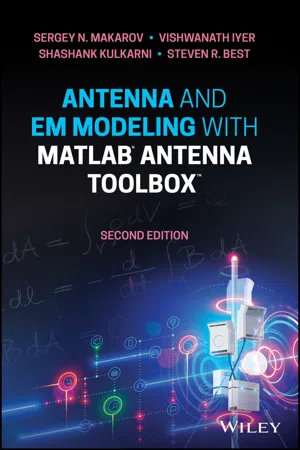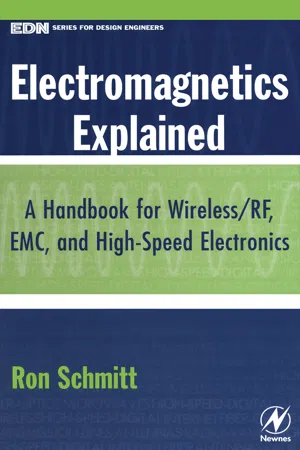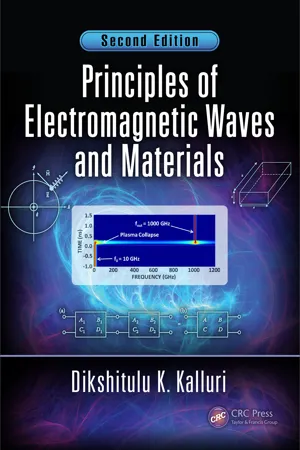Physics
Boundary Conditions for Electromagnetic Fields
Boundary conditions for electromagnetic fields refer to the requirements that the electric and magnetic fields must satisfy at the interface between different media, such as between air and a dielectric material. These conditions are essential for determining the behavior of electromagnetic waves and the transmission and reflection of these waves at boundaries. They are described by Maxwell's equations and are crucial in understanding the behavior of electromagnetic fields in various practical applications.
Written by Perlego with AI-assistance
8 Key excerpts on "Boundary Conditions for Electromagnetic Fields"
Learn about this page
Index pages curate the most relevant extracts from our library of academic textbooks. They’ve been created using an in-house natural language model (NLM), each adding context and meaning to key research topics.
- Sergey N. Makarov, Vishwanath Iyer, Shashank Kulkarni, Steven R. Best(Authors)
- 2021(Publication Date)
- Wiley(Publisher)
Note that the substitution does not change the form of this equation. Question: What else except for Maxwell's equations do we need to know to establish antenna radiation characteristics and be able to model antennas and other RF circuits? Answer : Boundary conditions for Maxwell's equations are critical for both analytical and numerical methods. They are briefly reviewed in Section 3.2. 3.2 BOUNDARY CONDITIONS 3.2.1 General Material Interface Along with the electric and magnetic fields, and, we introduce the electric flux density,, and the magnetic flux density,. On the interface between two materials (dielectric, magnetic, or metal), the following boundary conditions are employed, either in time or frequency domain (medium I and medium II are those from Figure 3.1): (3.2a) (3.2b) (3.2c) (3.2d) 3.2.2 Metal–Dielectric (Metal–Air) Interface On a metal surface S of a perfect electric conductor or PEC (represented by “inner” medium II in Figure 3.1), the tangential component of the total electric field vanishes, that is (3.2e) where tan denotes the tangential component of the E ‐field that is parallel to the surface. The proof is based on Eq. (3.2d) which uses the fact that within a perfect conductor. Otherwise, an infinite current would flow there, due to infinite conductivity. Figure 3.1 Problem geometry for boundary conditions at a media interface. Note: The PEC boundary condition (3.2e) is a good approximation to reality for antennas operating at approximately 10 GHz or lower. The PEC boundary condition implies no loss. At higher frequencies, the concept of a surface impedance should be used. The normal component of the electric field at the PEC interface could have any nonzero values associated with the distributed surface charges. There is no electric or varying magnetic field within the perfect electric conductor. Therefore, the boundary condition for the magnetic field is trivially obtained from the Ampere's law Eq. (3.1a) using Eq- eBook - ePub
Ultra Wideband Antennas
Design, Methodologies, and Performance
- Giselle M. Galvan-Tejada, Marco Antonio Peyrot-Solis, Hildeberto Jardón Aguilar(Authors)
- 2017(Publication Date)
- CRC Press(Publisher)
12 ]. Hence, it is clear that, mathematically and physically, the key point on the solution of the EM fields is the current distribution on the element under study, which is altered by boundary conditions. For this reason, it is important to address the meaning of both boundary value conditions and current distribution, as will be exposed in following sections.9.2 Boundary Value Conditions
Now at this point, it is important to remark that the solution of the Maxwell’s equations are subject to the boundary conditions imposed by the antenna geometry. In order to explain this concept, let us assume there is a certain structure (formed by a conductor or a combination of conductor and dielectric) of volume V in free space as depicted in Figure 9.1 , where ε r is the relative permittivity and µ r is the relative permeability of the structure, which is also assumed to have a charge density ρ and a current density J .We are interested in solving the relationship of the electric and magnetic fields not only at any point of free space due to the enclosed charge into the structure, but also at the boundary of it where there is a transition from one region (conductor/dielectric) to another one (free space). Then, let us illustrate a piece of the surface that encloses the volume V of Figure 9.1 as shown in Figure 9.2 , which is a thin surface layer S between two regions R 1 and R 2 .Figure 9.1 Arbitrary volumetric structure.Figure 9.2 Thin surface layer.This surface layer is characterized by having a surface charge density ρ s and a surface current density K , which introduce discontinuities in some field components.9.2.1 Normal components
In the case of the normal components, there exists, on the one hand, a discontinuity in the component of ε 0 E normal to the surface containing a layer of charge that is equal to ρ s at this point. Mathematically,n ⋅ε 0(=)E 1−E 2ρ swhere E 1 and E 2 are the electric field in regions R 1 and R 2 of Figure 9.2 , respectively. On the other hand, the components of µ 0 H - eBook - ePub
Engineering Electrodynamics
Electric Machine, Transformer, and Power Equipment Design
- Janusz Turowski, Marek Turowski(Authors)
- 2017(Publication Date)
- CRC Press(Publisher)
quasi-stationary fields ). The structure of conducting elements is such that one can neglect the eddy-current effect (e.g., laminated iron cores, split and transposed conductors), or when conducting parts are outside the investigated region. Many fields fulfill these conditions. This is the reason for application as well as the practical significance of the method of potential fields.2.2.3 Boundary and Initial Value Problems of Electrodynamics
Most of the calculation tasks of electrodynamics are reduced to solutions of the so-called limit value problems that consist of searching for a region of such a harmonic function ,* which fulfills the limit (border) conditions. The limit (border) conditions are divided into boundary conditions (on a surface S or a boundary line L ) and initial conditions (for time t = t 0 ).The basis for determinating a full solution depend on conditions existing on the body surface and is the theorem on exclusivity of field, also called uniqueness theorem . According to the uniqueness theorem applied to solutions of Maxwell’s equations, spatial and temporal boundary conditions univocally define the function describing the field in a linear and isotropic medium. This theorem states [1.11] that:If for given time t = t 0known are the electric and magnetic field intensities in an arbitrary point of area bounded by some surface, then one can, with Maxwell’s equations, calculate all the electromagnetic values at a time instant t - eBook - ePub
- Philip C. Magnusson, Andreas Weisshaar, Vijai K. Tripathi, Gerald C. Alexander(Authors)
- 2017(Publication Date)
- CRC Press(Publisher)
10Electromagnetic Fields and Maxwell's Equations
Classical macroscopic electromagnetic theory does not take account of quantized, atomic-scale effects, but postulates a set of mathematically described vector fields that are "smooth" and continuous in space. This assumption is generally valid for transmission line and waveguide applications at all frequencies from zero through the microwave range.* Interrelationships among the fields may then be formulated within an incremental-sized region, the region may be shrunk to a geometric point by limiting processes, and the results expressed as a set of differential equations known as Maxwell's equations.The principal fields will be designated as (1) magnetic flux density** (B, teslas, equivalent to webers per square meter); (2) magnetic field intensity (H, amperes per meter); (3) electric flux density (D, coulombs per square meter); and (4) electric field intensity (£, volts per meter). They must be related to one another and to the circuit quantities of current and voltage in such a manner as to account for observed mechanical forces and other effects within any "electrically activated" system.To obtain explicit solutions for the fields in particular geometrical situations, such as the space between two infinitely long concentric cylinders (coaxial cable) or within an infinitely long rectangular tube (rectangular waveguide), coordinate systems are introduced.10-1 An Overview of Classical Electromagnetics
3 ,7 ,8 ,10It is helpful to review some of the basic concepts of the electromagnetic fields, with emphasis on those aspects which bear directly on wave propagation. In so doing it will be assumed that the reader has studied (a) the operations and functions of vector analysis (key definitions and formulas are summarized in Appendix A) and (b) the basic concepts of static and quasistatic electric and magnetic field theory. The latter will be recapitulated here in order to provide a logical base for applications of Maxwell's equations and the accompanying boundary conditions. - eBook - ePub
Electromagnetics Explained
A Handbook for Wireless/ RF, EMC, and High-Speed Electronics
- Ron Schmitt(Author)
- 2002(Publication Date)
- Newnes(Publisher)
The simplest electromagnetic shield is just a conductor sheet. To learn how a shield works, assume for the moment that it is made from a perfect conductor. A perfect conductor is a conductor with zero resistance. As a consequence, the electric field must be zero inside a perfect conductor, otherwise the current would become infinite. For perfect conductors, all current must travel in an infinitesimally thin layer at the surface of the conductor. Since an electric field cannot exist inside a perfect conductor, it follows that electromagnetic waves cannot travel into a perfect conductor. When an electromagnetic wave impinges on a perfect conductor, 100% of the wave energy is reflected because no energy can enter the conductor, thus explaining that a perfect conductor is also a perfect reflector.REFLECTION OF RADIATION AT MATERIAL BOUNDARIES
Wherever a boundary between two materials occurs, reflections of waves will occur. The situation is just like that of impedance boundaries in transmission lines. The reflected waves can be calculated from the electric and magnetic reflection equations:where η1 is the intrinsic material impedance of the first region and η2 is the intrinsic material impedance of the second region. The electric field is analogous to the voltage in a transmission line, and the magnetic field is analogous to the current in a transmission line. For air the intrinsic impedance is approximately that of free space:For a conductor, the intrinsic impedance isFigure 9.1 plots the intrinsic impedance of copper across a wide frequency range. When a radio wave traveling through air encounters a slab of copper, a reflection results. The resulting reflection coefficient is complex, implying a phase shift of the reflected wave.Figure 9.1 Magnitude of wave impedance in copper. In copper, the wave impedance is a complex number and is equally split between real and imaginary parts.Figure 9.2 plots the reflection coefficient for a radiating wave incident upon a thick sheet of copper for a broad range of frequencies. Notice that the vast majority of the incident power is reflected at all frequencies. This result is valid only for radiating or far-field electromagnetic energy. As you learned in Chapter 5 - eBook - ePub
- Wai Kai Chen(Author)
- 2004(Publication Date)
- Academic Press(Publisher)
In addition, domains and hysteresis are introduced. Inductance relating the magnetic flux to the current is defined. The concept of a magnetic circuit, which finds important applications in power transformers, is also introduced. Chapter 2 is devoted to the fundamental theory of electrostatics. The concept of electric field and potential based on Coulomb’s law and Gauss’s law is introduced. Electric energy and force based on the field and potential are described. Boundary value problem based on the Poisson’s equation and Laplace’s equation for electric potential is formulated and canonical examples are given. Waves propagating in a homogeneous isotropic region are usually in the form of plane-waves. Chapter 3 describes the basic properties of plane waves for both lossless and lossy media. These basic properties include the nature of the electric and magnetic fields, the properties of the wave number vector, and the power flow of the plane wave. Special attention is given to the specific case of a homogenous (uniform) plane wave, i.e., one having real direction angles because this case is most often met in practice. Properties such as wavelength, phase and group velocity, penetration depth, and polarization are discussed for these plane waves. Chapter 4 describes the theory of transmission lines. Transmission equations for voltage and current are derived based on lumped-element circuit models. The propagation characteristics of both lossless and lossy lines are discussed with the latter emphasized on low-loss cases and cases lacking distortion. Useful parameters of a terminated transmission line, including impedance, reflection coefficient, voltage, and current, at various locations on the line are discussed in detail - Dikshitulu K. Kalluri(Author)
- 2017(Publication Date)
- CRC Press(Publisher)
the conductivity σ (S/m). A simple medium further assumes ε r, μ r, and σ to be positive scalar constants (see Figure 1.1). FIGURE 1.1 Idealization of a material as a simple medium. Such an idealization of material behavior is possible in the solution of some electromagnetic problems in certain frequency bands. In fact, the first course in electromagnetics often deals with such problems only. In spite of such an idealization, the electromagnetic problems may still need the use of heavy mathematics for analytical solutions due to the size, shape, and composition of the materials in a given volume of space. At a spatial interface between two materials, the fields on the two sides of the boundary can be related through boundary conditions (Figure 1.2): (1.14) n ^ 12 ⋅ D 2 − D 1 = ρ s, (1.15) n ^ 12 ⋅ B 2 − B 1 = 0, (1.16) n ^ 12 × E 2 − E 1 = 0, (1.17) n ^ 12 × H 2 − H 1 = K. FIGURE 1.2 Boundary conditions. In the above, ρ s is the surface charge density (C/m 2), K is the surface current density (A/m), and n ^ 12 a unit vector normal to the interface directed from. medium 1 to medium 2 as shown in Figure 1.2. 1.3 Time-Domain Electromagnetics The equations developed so far are the basis for determining the time-domain electromagnetic fields in a simple medium. For a lossless (σ = 0) simple medium, the solution is often obtained by solving for potentials A and Φ, which satisfy the simple form of wave equations (1.18) ∇ 2 A − 1 v 2 ∂ 2 A ∂ t 2 = − μ J, (1.19) ∇ 2 Φ − 1 v 2 ∂ 2 Φ ∂ t 2 = − ρ V ε, where (1.20) v = 1 μ ε. In obtaining the above equations, we used the Lorentz condition (1.21) ∇ ⋅ A + μ ε ∂ Φ ∂ t = 0. The terms on the right-hand sides of Equations 1.18 and 1.19 are the sources of the electromagnetic fields- G. Jagadeeswar Reddy, T. Jayachandra Prasad(Authors)
- 2020(Publication Date)
- CRC Press(Publisher)
Hz J D J C = 2 π 50 × 8.854 × 10 − 12 × 1 10 5 = 2.782 × 10 − 14 and for f = 50 MHz J D J C = 2.782 × 10 − 8 3.5 Boundary Conditions for Electric Fields So far we have seen an electric field on a single homogeneous medium. Now let us have an electric field in two different media. The conditions that the electric field satisfies at the interface of two media are called boundary conditions. Boundary conditions between dielectric-dielectric, conductor–dielectric and conductor-free space are determined as: To find boundary conditions we must use the Maxwell’s equations ∮ E ¯ ⋅ d l ¯ = 0 and ∮ s D ¯ ⋅ d s ¯ = Q e n c Also we have to decompose electric field strength, Ē into tangential component (Ē t) and normal component (Ē n). ∴ E ¯ = E ¯ t + E ¯ n (3.5.1) Similarly D ¯ can be decomposed 3.5.1 Dielectric – Dielectric Let us consider two dielectric media with ∊ 1 and ∊ 2 as shown in the Fig.3.7 where. ∊ 1 is the permittivity in medium 1 and ∊ 2 is the permittivity in medium 2. Fig. 3.7 Dielectric – Dielectric boundary for establishing relation between tangential components and ∊ 1 = ∊ 0, ∊ r 1, ∊ 2 = ∊ 0 ∊ r 2. Apply ∮ E ¯ ⋅ d l ¯ = 0 around abcda. loop 0 = E ¯ 1 t Δ W − E ¯ 1 n Δ h 2 − E ¯ 2 n Δ h 2 − E ¯ 2 t Δ W + E ¯ 2 n Δ h 2 + E ¯ 1 n Δ h 2 as Δh tends to ‘0’ the above equation becomes E ¯ 1 t = E ¯ 2 t (3.5.2) i.e., the tangential component in medium 1 is equal to the tangential component in medium 2. Hence the tangential component of electric field intensity is continuous at the interface. We know E ¯ = D ¯ ∊ based on this, the above equation becomes D ¯ 1 t ∊ 1 = D ¯ 2 t ∊ 2 (3.5.3) Hence the electric flux density is discontinuous. To find the relation between normal components consider a small cylinder which intersects both the media as shown in the Fig.3.8. Fig







